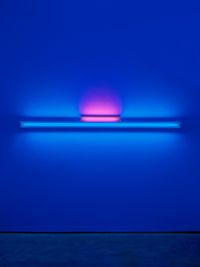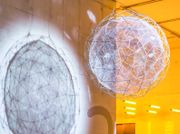Daniel Nicholas Flavin Jnr was a pioneer light artist and installation-maker associated with the Minimalist movement.
Read MoreRaised in Queens, New York in an Irish Catholic family, Flavin was initially attracted to being a priest, but became interested in art while serving in the U.S. Air Force in Korea with his brother. In the late 1950s he worked in the Guggenheim sorting mail and at the Museum of Modern Art as a guard and elevator attendant. There, he met Sol LeWitt, Robert Ryman, and future critic, Lucy Lippard.
Flavin was interested in simple linear forms and rudimentary serial groupings using carefully positioned white or hued fluorescent tubes. The cool light of the tubes interacted with the walls, floors, corners, and windowless corridors of gallery architecture, radiating delicate washes of diffuse colour.
Although his material was the properties of light, Flavin denied intending spiritual symbolism. He started as an abstract expressionist, but then avoided gesturalism by attaching electric bulbs or tubes to monochromatic Masonite boxes that hung on the wall. An example is icon V, Coran's Broadway Flesh (1962), with its rows of incandescent 'candle' bulbs on the outer edges of a pink box.
Flavin then abandoned the painted panels to concentrate on the metal casings and their enclosed glowing tubes, looking also at their supporting walls and the adjacent floor and ceiling. The reflected dissolving light and cast shadows produced breakthrough works like The diagonal of 25 May, 1963 (to Robert Rosenblum) (1963), with its single eight-foot-long glowing diagonal line.
Flavin discovered each work was just as dependent on its unique architectural positioning as the electricity that lit it up. His work had a discreet presence, with the viewer becoming aware of the flickering pulse of the circulating gas within the long thin cylinders, the hum of the circuitry in the store-bought industrial fittings, and the juxtaposition of mingled pastel colours.
Flavin consistently denied the existence of an emerging developing practice, claiming the various ideas emerged all at once in the early 1960s. However writer and artist David Batchelor has argued that they did change in their degree of complexity. Works like untitled (in memory of my father, D. Nicholas Flavin) (1974), a long double row of pale blue fluorescent circles; or untitled (to Helga and Carlo, with respect and affection) (1974), a long double row of pale blue fluorescent squares, would support that. However the complex pyramid-shaped series '"monument" for V. Tatlin', first appeared in 1964.
Untitled (1989) is a single corner work with six vertical tubes directed into a corner, and in front of them, six horizontal tubes facing towards the viewer and open floor, emitting a very different colour. Gorgeous and complicated, it contradicts Flavin's mentioned claim that 'all my diagrams (for my proposals), even the oldest, seem applicable again and continually.' Whilst a variation of a template, it also supports Batchelor's view of increasing intricacy.
Flavin's works were sometimes compared to the paintings of artists of his time like Morris Louis. Flavin resented being thought of as a sculptor.
Planning his works through drawings and notes, Flavin executed them in limited editions—not making them until they were sold.
Dan Flavin has participated in the following select solo exhibitions: Dan Flavin, David Zwirner, Paris (2019); Dan Flavin: Corners, Barriers, and Corridors, David Zwirner, New York (2015); Dan Flavin: A Retrospective (2004—2007), DIA Art Foundation, New York, toured U.S.A., England, France, and Germany (2004); Drawing and Diagrams from Dan Flavin 1963—1972; Corners, Barriers and Corridors in Fluorescent Light from Dan Flavin, The St. Louis Art Museum (1973); Flourescent Light, Etc. From Dan Flavin, National Gallery of Canada, Ottawa (1969); Dan Flavin: Alternating Pink and 'Gold', Museum of Contemporary Art, Chicago (1967).
The artist has also participated in the following group exhibitions: Dan Flavin, to Lucie Rie and Hans Coper, master potters, Vito Schnabel Gallery, St. Moritz, Switzerland (2017) and Documenta 4, Kassel (1968).
On Ocula, the artist is represented by David Zwirner, Krakow Witkin Gallery, and PKM Gallery. Recent exhibitions hosted by David Zwirner include Flavin, Judd, McCracken, Sandback (2021), Miami NY (2020), and Parallax (2020).
John Hurrell | Ocula | 2021





